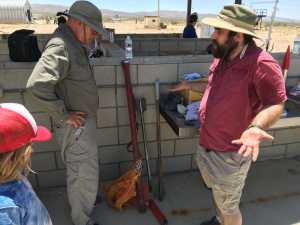The monthly meeting of the RRS was held June 9, 2017, at the Ken Nakaoka Community Center in Gardena. The meeting was called to order at 7:45pm.
The launch event with UCLA was successful. We accomplished a lot with many different groups present. Again, we thank Dave Crisalli for being our pyro-op for the event. The RRS discussed the event and how we could manage these events in a more orderly fashion.
Several steps for improvement were discussed including tighter control of incoming vehicles and setting our operating procedure into written form for publication. In the future, the RRS should require all attendees to the MTA send their indemnification forms well in advance of the event so we know how many people we are expecting. Also, we need to use a full 10 second count instead of the 5 second count which will allow more time for the spotter to stop the launch if a problem is detected. An earlier draft of the RRS operational safety codes exists and was approved. The RRS secretary will circulate a new draft to the executive council before the next meeting on July 14th.
Minor facility improvements were discussed including how to mitigate the stifling heat at our desert site. Frank was willing to buy a water-fed misting fan that might help some people inside the Dosa building or perhaps inside the bunker. If the device works well, the RRS may consider buying a second unit to help create a small cooling space for those who are most affected by the heat.
I sat in my truck’s air conditioning a few times that afternoon as wearing the fireproof suit for the micrograin loading operations only added to my mounting heat exhaustion. Dave Crisalli had mentioned there are vests that hold flat ice packs that can be worn inside of protective suits. This will buy some time to work more comfortably under hot conditions.
Hydration, sunscreen and proper clothing for the desert heat are always important to all individuals to protect themselves both before and during the events held at the RRS MTA. The Mojave Desert is a tough place. It’s this attention to these details that are key parts of everyone having a successful event. As we do operate year-round through the hot months, there will always be this hazard to manage.
We reviewed the video shot from the launches. It has been suspected that the existing micrograin launch rails are a little too short resulting in the rockets leaving less than straight from the rails. We discussed newer longer rail launchers. It was decided to try to recover an old rail system that is already at the MTA as a backup.
Frank brought several old paper copies of the RRS newsletters. Some of these date back to the early 1950’s and others were from the 1960’s. The RRS is actively working to electronically archive as much of these newsletters as part of our on-going RRS history project.
Issue 101 mentions a story where the RRS was on the old Louis Lomax show which was a local semi-weekly news program in Los Angeles from 1964-1968. John Mariano and George Dosa were there and we hope to someday find the archival footage and post this to our YouTube channel. (I think it was Issue 101? Someone correct me if I am mistaken.)
Louis Lomax – Wikipedia
The RRS has in fact set the date for the upcoming 75th anniversary symposium which will be April 14, 2018. We will have it at the Ken Nakaoka Community Center as before. We have already begun the process of contacting speakers and exhibitors. We hope to make this event even better than this last year.
John Mariano brought his rocket on a string. This is a classic demonstration of the fundamental principle of propulsion using a CO2 cartridge guided on a plastic clothesline. The rocket was easily able to traverse the full length of the Ken Nakaoka Community Center ballroom, even uphill to the stage where Larry was holding the stop. Bill and I took video of the event and its on the RRS YouTube channel. Link is below:
After some false starts in getting the spring loaded puncturing device to work, we got it to work. Simple, but very fun! This demonstration of the fundamental principle of jet propulsion is a favorite in our educational events.
The RRS is looking forward to doing an educational event with the students of Nickerson Projects in Watts. After the teaching sessions, the launch event is scheduled for July 22nd. Larry has an RRS standard alpha for the demonstration. The RRS is grateful to the LAPD CSP program for helping put this together.
We adjourned the meeting at 9:10pm. Next meeting will be July 14, 2017, just before the launch event with Nickerson Projects in Watts that next Saturday, July 22nd.
If there is anything I missed or mistated, please let me know.
secretary@rrs.org






































